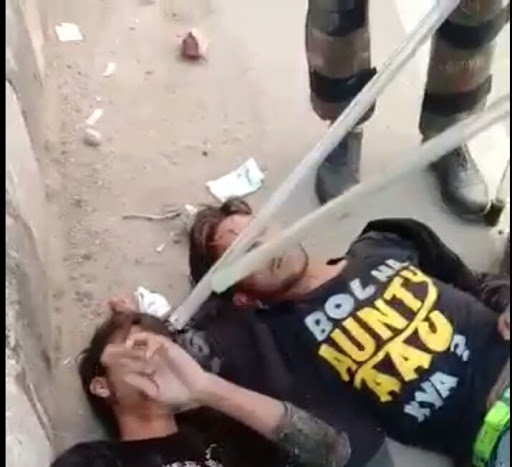
A Delhi Armed Policeman, has been questioned in connection with the Northeast Delhi riot case where injured men were forced to sing the national anthem even as they lay bleeding on the road. One of the victims, 24-year-old Faizan, succumbed to his injuries later. The video of the incident was shared over social media and whatsapp when the incident first came to light on February 25, during the communal violence of Northeast delhi. The video showed the three men, writhing in pain on the ground surrounded by a group of Delhi police personnel, who stood by, purportedly taunting and ordering them to sing the National Anthem, and also Vande Mataram, occasionally, hitting them with their lathis. Faizan, a resident of Kardam Puri, succumbed to injuries at LNJP Hospital. Dr Kishore Singh, medical director of the hospital, had been quoted by the IE, “He was admitted to the neurosurgery ward on February 25 and died three days later. He had suffered gunshot wounds and was critical.”
According to an exclusive report filed by the Indian Express, the Delhi Police Crime Branch has now questioned a policeman posted with the Delhi Armed Police, as a part of the investigations into the circumstances around Faizan’s death. The families of two other men seen in the video clip had told The Indian Express that the video was shot at Kardam Puri on February 24. Faizan’s mother and sisters had confirmed to news reporters, as well as civil rights groups including Amnesty that he was one of the men in the video clip. Her statements were quoted in many news reports as well as reports by fact fainting teams.
The IE stated that while the video that went viral was recorded by one of the police personnel, it was another video of the same incident, shot from afar, that helped the police in their investigation. An FIR was filed on February 28 at Bhajanpura police station, but the case was later transferred to the Crime Branch. The investigators began by checking how many police personnel were deployed in that neighbourhood from which police stations, stated the IE, adding that the incident took place at 66 Foota Road, under the jurisdiction of Bhajanpura police station, but investigators found that no personnel from that station were deployed in the area at the time.
“Investigators found that the location was surrounded by areas that fall under the jurisdiction of other police stations, and there was a strong possibility that personnel from a different location had arrived at the scene during the riots,” a senior police officer is quoted by IE. The report quotes sources that said “while scanning the video recorded from afar, investigators noticed that one of the personnel was “carrying tear smoke munitions (TSM)”.” These TSM are issued under the police persons own name. The investigating officer verified entries of TSMs issued that day, identified a personnel posted with the DAP reported IE. The man has been questioned by the Special Investigation Team (SIT) at their office at Darya Ganj. The investigations are underway,” the IE reported, adding that the footage captured from afar shows at least six personnel, and investigating officers are trying to zero in on the rest.
In its recent report investigating the riots, Amnesty International had also taken note of the video that went viral on social media. After the video was shot, the men were taken to the police station on the same day and detained.
Kismatun the mother of 26-year-old Faizan, the man who died, had told Amnesty she had seen the video several times but did not realise until much later that her son was also there in the video. “I went to the police station along with my son’s photograph. I showed them his photograph and asked if he was there and they said yes. I asked them if they would let me see him and if they would let him go. The policeman said no. But I still waited there till 1 o’clock in the night,” she said. Faizan was detained by the police for close to 36 hours without any charge. He was handed over to his mother at 1 AM on 26 February after his condition deteriorated. The police refused to give any paperwork to the family to show that he had been detained, stated Amnesty.
“I asked them why they were allowing me inside the police station late in the night when just the previous night they had told me that women were not allowed. I said this after they handed over my son.” The policeman told her “to be grateful that I had got my son back and told me to go,” Kismatun told Amnesty International India. She took her son to a clinic where the doctors told media houses that he had “an open wound on his head and blood clots everywhere” and that his “pulse was fading”. His family admitted him to the Lok Nayak Jai Prakash Narayan hospital in New Delhi on the afternoon of February 26. He died the same night.
Despite multiple video evidence, the Delhi Police had denied that they tortured Faizan or unlawfully detained him, stated Amnesty. It added that the lack of investigation into the torture and subsequent death of Faizan signals towards the multiple violations committed by the Delhi Police that remain to be investigated.
Related:
Dialed 100 repeatedly, got no answer: Delhi riot survivor
Why do investigations into the Delhi riots appear to be a conspiracy in itself?
Stop coercing ‘confessional’ statements to manufacture evidence in Delhi Violence
Establish independent review of Delhi Police’s role North East Delhi riots: Amnesty